Frida Kahlo remains one of the most influential and iconic figures in modern art, celebrated not only for her striking self-portraits but also for the way she infused feminism, love, and suffering into every brushstroke. Her art and words reveal a deeply personal, unapologetic exploration of identity, relationships, and the human condition. Kahlo’s ability to express her inner world has kept her relevant across generations, inspiring artists, activists, and admirers who see her as a symbol of strength, vulnerability, and defiance.
No products found.
Feminism in Frida Kahlo’s Life and Art
Defining Feminism Through Self-Representation
Frida Kahlo never labeled herself a feminist in the way we understand the term today, yet her life and art embodied core feminist ideals. She challenged beauty standards by painting herself with facial hair, unidealized features, and traditional Mexican clothing that celebrated her heritage. Her choice to dress in Tehuana attire was both a personal and political statement, asserting pride in indigenous culture and resisting Western beauty norms.
Women’s Autonomy and Body Politics
Kahlo’s paintings often addressed topics that were taboo in her time — miscarriage, female sexuality, and chronic illness. Works like Henry Ford Hospital present raw depictions of pain, showing that women’s experiences, both physical and emotional, deserved space in the art world. These were acts of radical self-exposure that rejected societal pressures to remain silent or polished.
Public Persona and Private Resistance
Even in public life, Kahlo defied expectations. She navigated the male-dominated art scene alongside prominent figures like Diego Rivera while asserting her own artistic voice. By becoming the subject of her own work repeatedly, she dismantled the male gaze and redefined how women could control their image.
Love in Frida Kahlo’s Story
The Complexity of Her Relationship with Diego Rivera
Frida’s love story with Diego Rivera was one of the most talked-about relationships in 20th-century art. Their marriage was a blend of passionate devotion and deep conflict, marked by affairs on both sides. While their bond brought artistic collaboration and mutual inspiration, it was also a source of recurring pain. Their love story is documented not just in photographs but in her emotional letters, many of which are explored in Exploring Frida Kahlo’s Letters to Diego Rivera, revealing vulnerability, longing, and moments of defiance.
Art as a Love Letter
Many of Kahlo’s paintings serve as visual love letters — not only to Diego but to Mexico, her family, and life itself. In works like The Two Fridas, she presents dual versions of herself, one tied to her love for Diego and the other reflecting her independence. This duality shows how love for another person coexists with the need for self-love.
Love Beyond Romance
Kahlo’s concept of love went beyond romantic attachment. She expressed profound affection for her culture, her friends, and her artistic community. This expansive view of love enriched her work and made her relatable to audiences who connect with love in all its forms.
Suffering as a Creative Force
The Influence of Physical Pain
From her teenage years, Frida battled debilitating health issues — first from polio and later from a catastrophic bus accident that left her with chronic pain. These experiences shaped much of her creative voice. Her suffering was not hidden; instead, she turned it into symbolic and often surreal visual language.
Emotional Turmoil in Her Work
Kahlo’s emotional suffering, whether from heartbreak, betrayal, or societal marginalization, became a recurring theme. She translated these feelings into symbolic imagery — broken columns, bleeding hearts, and stormy skies — to convey states of mind that words alone could not capture.
Transformation of Pain into Power
Rather than allowing suffering to silence her, Kahlo turned it into a source of empowerment. Her paintings told stories of survival and resilience, inspiring future generations to see art as a way to reclaim agency over personal hardship.
How Feminism, Love, and Suffering Intersect in Frida Kahlo’s Work
| Theme | Artistic Representation | Key Example | Impact on Viewers |
|---|---|---|---|
| Feminism | Self-portraits rejecting beauty norms | Self-Portrait with Cropped Hair | Encourages body positivity and autonomy |
| Love | Romantic and cultural devotion | The Two Fridas | Shows love’s complexity and dual nature |
| Suffering | Physical and emotional pain visualized | The Broken Column | Turns vulnerability into strength |
Frida Kahlo’s Enduring Influence
Today, Kahlo’s work continues to resonate not only in museums but also in fashion, activism, and popular culture. Her face appears on posters, clothing, and merchandise, transforming her into a global icon of self-expression and empowerment. Reproductions of her paintings, such as those found in Frida Kahlo Wall Art Prints, allow admirers to bring her bold vision into their homes, keeping her legacy alive in daily life.
No products found.
FAQ
Why is Frida Kahlo considered a feminist icon?
Because her art and life challenged societal norms, celebrated women’s autonomy, and gave voice to female experiences often excluded from mainstream narratives.
How did love influence Frida Kahlo’s art?
Her romantic relationships, especially with Diego Rivera, deeply shaped her work, inspiring themes of passion, betrayal, and emotional duality.
Why did Frida Kahlo paint her suffering?
She used her art to process and communicate her physical and emotional pain, transforming personal hardship into universal storytelling.
What can modern artists learn from Kahlo?
That vulnerability, cultural pride, and authenticity can create timeless connections with audiences.
How does Kahlo remain relevant today?
Her unapologetic embrace of identity and her fearless confrontation of difficult subjects make her work timeless and globally admired.





